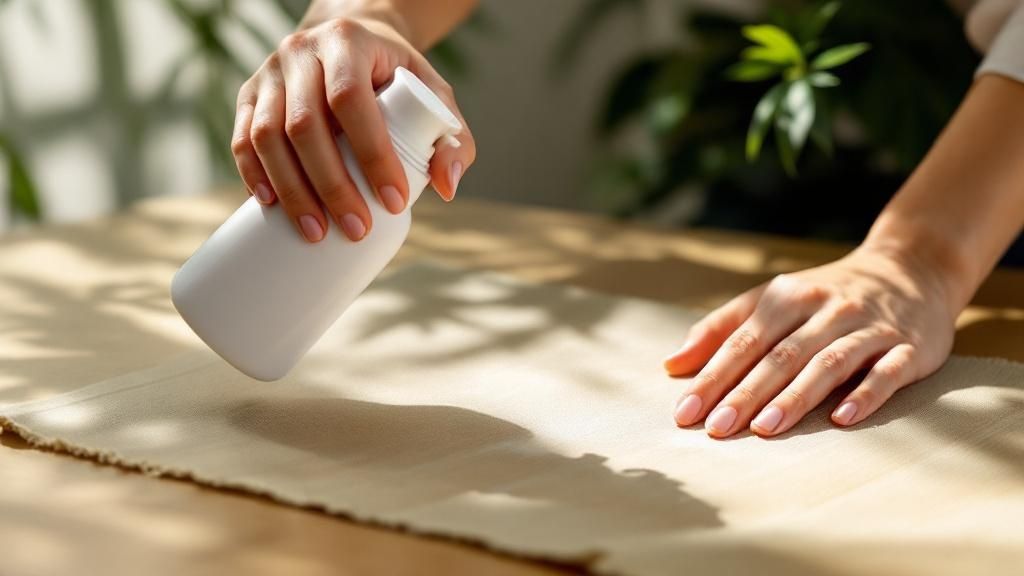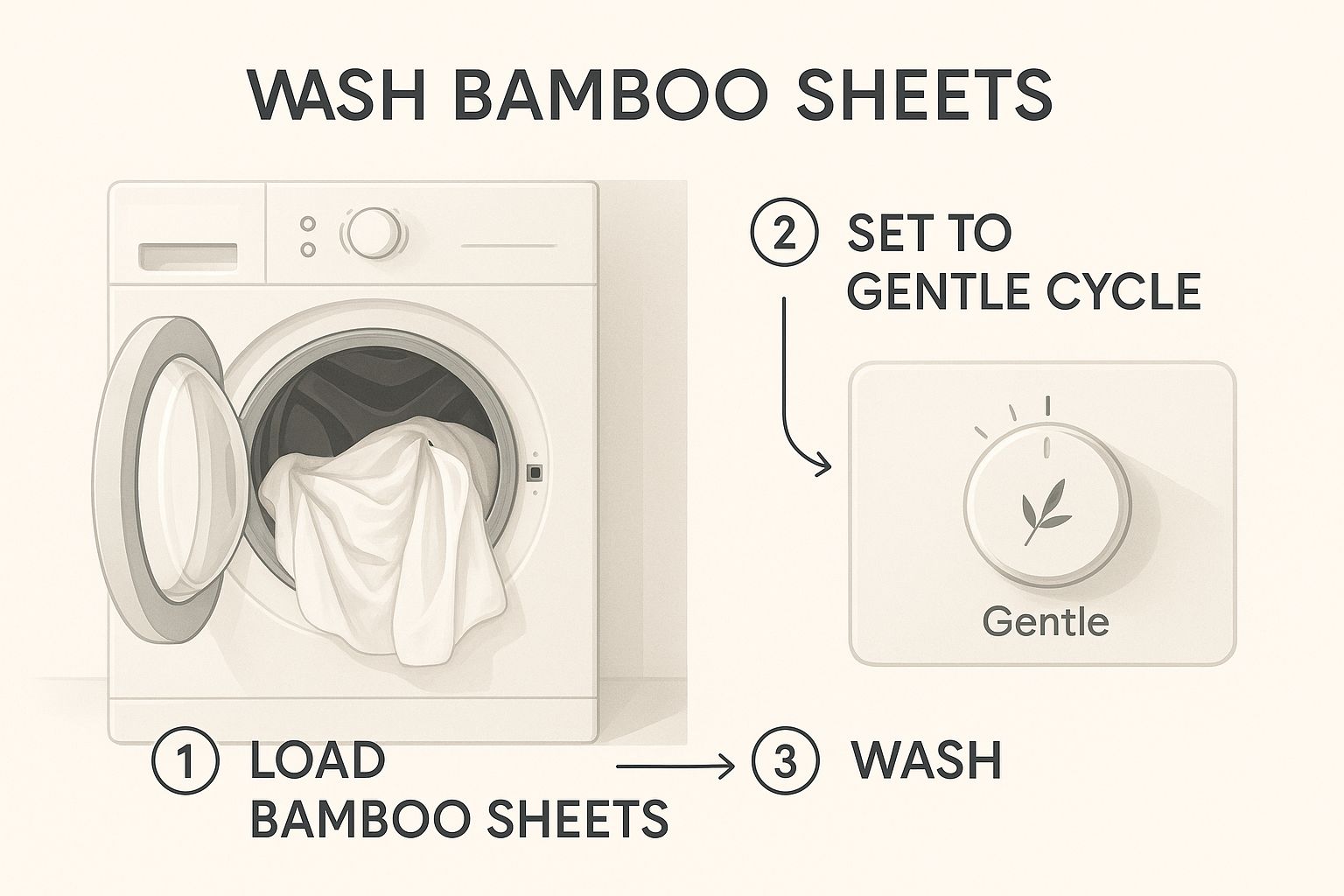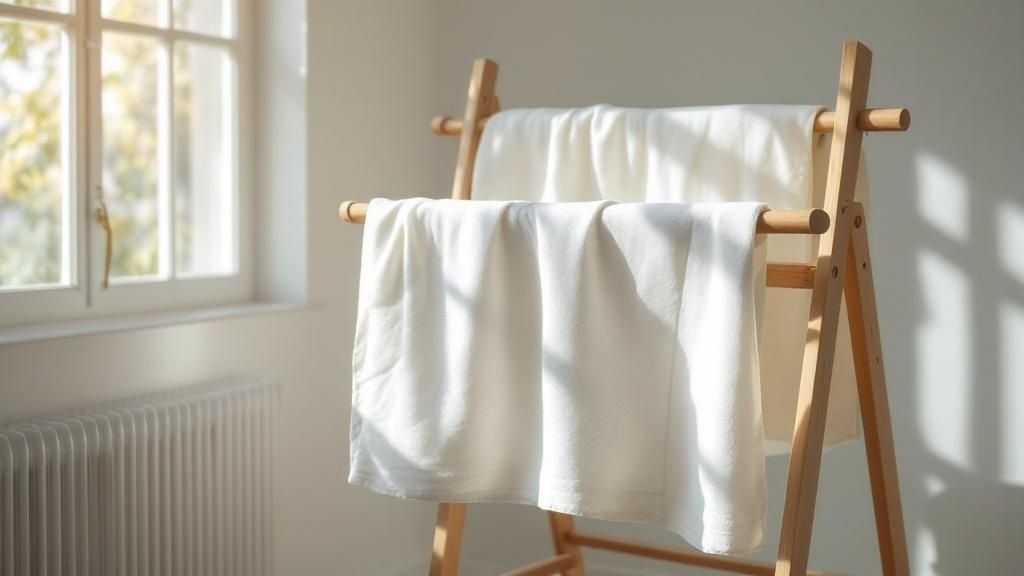You invested in bamboo sheets for that incredible softness and cool-to-the-touch feel, but keeping them that way takes a slightly different approach than you might be used to with cotton. The secret isn't complicated, though. It really just comes down to one simple rule: wash them in cold water on a gentle cycle using a mild, liquid detergent.
This one small adjustment is the key to protecting the delicate fibers that make your bedding feel so luxurious in the first place.
Why Bamboo Sheets Need a Little Extra TLC

That unbelievable softness isn't just a happy accident; it's the result of a specific process that turns tough bamboo pulp into the silky fabric you now enjoy. This process creates what's known as bamboo viscose, a material with a unique cellular structure. This structure is fantastic for making the fabric exceptionally soft, breathable, and moisture-wicking, but it also leaves it a bit more vulnerable in the laundry room.
Unlike the rugged nature of cotton, the delicate bamboo viscose fibers just don't stand up well to aggressive washing. That's why following the proper washing instructions for bamboo sheets is so critical for making them last.
Getting to Know the Viscose Fiber
To really get it, you have to understand where the fabric comes from. The care instructions are a direct result of the viscose manufacturing process, which uses a chemical treatment to break down bamboo pulp and spin it into soft rayon fibers. While this gives you a textile that’s often softer than high-end cotton, it also makes those fibers sensitive to high temperatures and harsh chemicals. You can get a deeper dive into how this all works over at Bamtek Home.
This sensitivity is exactly why you see warnings against common laundry additives and high-heat settings on the care tag. Using the wrong products or cycles can cause damage you can't undo.
The Bottom Line: The very thing that makes bamboo sheets feel so amazing also makes them delicate. High heat and harsh chemicals are their biggest enemies, causing shrinkage, pilling, and the loss of that signature silky texture.
Protecting your sheets just means making a few small tweaks to your laundry day routine. These simple changes can prevent the most common problems and keep your sheets feeling brand new for years.
Here are the main things that can ruin your bamboo sheets:
- High Heat: This is the worst offender. It causes the fibers to shrink and can make them brittle, stripping away their softness.
- Harsh Chemicals: Bleach and aggressive detergents can literally weaken and break down the viscose structure.
- Fabric Softeners: It sounds counterintuitive, but softeners coat the fibers, which clogs them up and reduces their natural breathability and moisture-wicking abilities.
- Aggressive Agitation: A rough wash cycle, or washing them with heavy, abrasive items like jeans or towels, can lead to pilling and snags.
The Correct Way to Wash Bamboo Sheets
When you've invested in bamboo sheets, you want to keep that incredible silky softness for as long as possible. The secret isn't complicated; it's all about gentle care. Forget what you know about washing regular cotton—bamboo fabric needs a much lighter touch.
Think of it like this: harsh cycles and aggressive detergents are the enemies of bamboo's delicate fibers. Your best friend here is a mild, pH-neutral liquid detergent. Powdered detergents can sometimes leave a residue that makes the fabric feel stiff, so it's best to stick with a liquid. And whatever you do, steer clear of bleach and fabric softeners. These products coat and ultimately break down the very fibers that make your sheets so luxurious.
Selecting the Right Machine Settings
Getting the machine settings right is probably the most important part of the whole process. Always, and I mean always, choose the gentle or delicate cycle. This setting is designed to minimize the physical stress on the fabric, which goes a long way in preventing pilling and snagging.
The other absolute must is to watch your water temperature. Keep it cool. We're talking below 30°C (that’s about 86°F). Washing your bamboo sheets in cold water is the single best thing you can do to prevent them from shrinking and to preserve their softness and strength for years to come.
This visual guide breaks it down perfectly.

As you can see, a cool, gentle wash is the foundation of proper care. Following this straightforward approach will protect the integrity of the bamboo viscose fibers, ensuring your sheets stay in top condition.
To make things even simpler, here's a quick cheat sheet for the perfect wash every time.
Bamboo Sheet Washing At a Glance
| Setting | Recommendation | Why It Matters |
|---|---|---|
| Cycle Type | Gentle or Delicate | Reduces friction and prevents pilling or snagging. |
| Water Temperature | Cold (Below 30°C / 86°F) | Prevents shrinking and preserves fiber softness. |
| Detergent | Mild, pH-Neutral Liquid | Cleans effectively without leaving residue or damaging fibers. |
| Additives | Avoid Bleach & Softeners | These harsh chemicals coat and weaken the delicate fabric. |
Following these guidelines will take all the guesswork out of laundry day and keep your sheets feeling brand new.
Give Your Sheets Their Own Wash Cycle
This might be the most overlooked piece of advice I give people: wash your bamboo sheets by themselves. It’s tempting to just toss them in with everything else to save time, but that’s a recipe for disappointment. Mixing them with other items, especially heavy or rough ones, is a big mistake.
- Towels are a no-go. Their rough, loopy texture acts like fine-grit sandpaper against the smooth bamboo fibers, causing them to pill.
- Watch out for zippers and buttons. Things like jeans and hoodies have hardware that can easily catch and snag the fabric, leading to pulls and even small tears.
- Keep heavy fabrics separate. Washing sheets with bulky items like denim causes them to get tangled and twisted, which can stretch the fibers unevenly.
Giving your sheets their own load creates a low-friction environment where they can be cleaned thoroughly but gently. For a deeper dive into the dos and don'ts, take a look at our complete guide on how to care for your bamboo sheets.
Pro Tip: Before you start the wash, always close duvet covers and turn pillowcases inside out. This little trick stops smaller items from getting trapped inside and protects the outer surface from unnecessary wear and tear.
Drying Bamboo Sheets Without Damage

Just as you take care washing your bamboo sheets, the drying process is equally critical. If you take away only one thing, let it be this: high heat is the absolute enemy of bamboo viscose. It's the fastest way to shrink your sheets, ruin that signature softness, and make the delicate fibers brittle.
The best method, by far, is letting them air dry on a line. It’s the gentlest way to treat the fabric and will dramatically extend the life of your sheets, keeping them feeling brand new for much longer.
A quick tip for line drying: try to drape the sheets over the line instead of pinning them by the corners. This little trick helps spread the weight out, preventing the wet fibers from stretching and losing their shape.
Using a Machine Dryer Safely
Let’s be real—line drying isn't always practical. You can use a machine dryer, but you have to be careful. The goal is to avoid high temperatures at all costs.
Always, and I mean always, use the lowest heat setting your dryer has. This is usually called 'tumble dry low' or sometimes 'air fluff'. These settings use very little (or no) heat, so they gently tumble the moisture out instead of baking it out. It takes longer, but it's a trade-off that will save your sheets.
Pro Tip: Try pulling your sheets from the dryer when they are still just a little bit damp. This is one of the best ways I've found to prevent deep wrinkles and keep the fabric feeling incredibly soft and smooth.
To get the most out of machine drying while still protecting your investment, a couple of simple additions can make a huge difference.
-
Wool Dryer Balls: I highly recommend swapping out your standard dryer sheets for a set of wool dryer balls. They bounce around in the drum, separating the fabric and allowing air to circulate more freely, which actually helps speed up the drying time on that low-heat setting.
-
Natural Softening: Besides being great for airflow, these wool balls are a fantastic natural fabric softener. They don't leave behind the waxy residue that dryer sheets do—a residue that can clog the fabric's pores over time and reduce its amazing breathability.
Follow these simple drying tips, and your bamboo sheets will stay the softest, most comfortable part of your sleep sanctuary.
Common Mistakes That Ruin Bamboo Bedding
We’ve all done it. You invest in something wonderful, like a set of premium bamboo sheets, and then accidentally shorten its lifespan with a simple laundry mistake. It happens more often than you'd think. When it comes to bamboo, knowing what not to do is just as crucial as following the right care instructions.
Let's dive into some of the most common errors I've seen that can quickly turn those silky, soft fibers into a frustrating mess.
The Problem with "Softness" Additives
The biggest offender? Fabric softener and dryer sheets. It seems counterintuitive, I know. You want your sheets to be softer, so you reach for the bottle that promises just that. But these products are the absolute enemy of bamboo fabric.
They work by coating the fibers in a thin, waxy film. This residue clogs the natural weave of the bamboo viscose, suffocating it. The result is a total loss of breathability and moisture-wicking power—the very qualities that make bamboo so incredible in the first place. You're essentially paying for premium features and then immediately erasing them.
Harsh Chemicals and A Crowded Machine
Another major mistake is reaching for chlorine bleach. It's a powerful stain fighter, but it's far too aggressive for the delicate structure of bamboo fibers. Bleach will literally eat away at the fabric over time, causing it to weaken, yellow, and tear.
If you're dealing with a stubborn stain, reach for an oxygen-based brightener or an enzyme cleaner instead. These are much gentler on the fabric. For a complete rundown on safe washing and stain-fighting methods, our guide on how to properly wash bamboo sheets has you covered.
It’s not just about what you put in the washer, but also how much. Cramming too much into the machine is a recipe for disaster. When your sheets don't have room to move, they rub against each other aggressively. This friction is what causes those annoying little pills to form and puts a ton of stress on the seams.
Key Takeaway: Steer clear of harsh chemicals and additives. Fabric softeners, dryer sheets, and chlorine bleach are the top three culprits that can permanently damage the delicate structure of bamboo viscose, leaving your sheets stiff and shortening their life.
The Final Step: Smart Storage
Finally, let's talk about storage. Tossing your clean sheets into a plastic bin or bag seems like a smart way to protect them, right? Unfortunately, plastic traps any hint of residual moisture, creating a breeding ground for mildew and musty smells. It can even lead to yellowing over time.
The best practice is to store your completely dry sheets in a cool, dark place with plenty of air circulation. Think a linen closet with slatted shelves or even a breathable cotton storage bag. This keeps them fresh and ready for your next perfect night's sleep.
Keeping Your Sheets Feeling Brand New
Great sheets deserve great care, and it goes way beyond just throwing them in the wash. If you want to keep that incredible softness and luxurious feel of your bamboo bedding, a few simple, consistent habits can make all the difference. Think of it as protecting your investment in better sleep.
The biggest factor? Finding the right washing rhythm. Bamboo fabric is strong, but like any premium material, over-washing can take its toll. I've found that washing my sheets about once a week is the sweet spot. It's frequent enough to handle the natural body oils and sweat that build up, but not so often that it puts extra stress on those delicate viscose fibers.
Create a Smart Rotation and Handle Stains Like a Pro
Here's a tip I give everyone: always have at least two sets of sheets. Rotating them is a game-changer. By giving one set a "rest" while the other is in use, you dramatically cut down on the wear and tear from both sleeping and laundering. It's a small change that can seriously extend the life of your bedding.
And when life happens—spills, smudges, you name it—the key is to act fast but gently.
- Don't wait. The sooner you treat a stain, the better your chances of getting it out completely.
- Grab an enzyme cleaner. These are designed to break down the proteins in common stains without being harsh on the fabric itself.
- Blot, never scrub. Rubbing a stain can push it deeper into the fibers and cause damage. A gentle blotting motion is all you need.
When you care for them properly, bamboo sheets can last an incredibly long time—up to 6 years. That's a lifespan roughly 20-30% longer than many cotton sheets, which is a huge plus for anyone who values durability. For more on this, check out the insights on Hush.ca.
These little routines are truly the secret to making your sheets feel silky and new for years. For a deeper dive, take a look at our complete guide on cleaning bamboo sheets.
Your Bamboo Sheet Care Questions Answered
Even with the best instructions, trying a new fabric for the first time usually brings up a few questions. I've heard just about all of them when it comes to bamboo bedding, so I’ve put together this quick guide to tackle the most common uncertainties. My goal is to give you clear answers so you can feel confident you're doing it right.
Solving Common Laundry Mysteries
A big question I get is about ironing. "Can you iron bamboo sheets?" The short answer is yes, but you have to be incredibly careful. If you absolutely feel the need to iron them, stick to the lowest possible heat setting. High heat can easily scorch the delicate viscose fibers, and that's damage you can't undo.
Honestly, a much better approach is to skip the iron altogether. Just pull the sheets from the dryer while they're still the tiniest bit damp. Put them straight on the bed, and they'll smooth themselves out naturally as they finish drying.
What about that occasional stiffness you might feel right out of the wash? This is almost always caused by leftover detergent. Bamboo fibers are so smooth that they don't need much soap to get clean, and using too much can leave a film.
If your sheets feel stiff, don't worry. Just toss them back in for an extra rinse cycle—no detergent this time. That will wash away the residue and bring back that signature, silky softness.
Proper storage is another thing people often ask about. What’s the best way to store them?
- First, make sure they are bone dry before putting them away to avoid any chance of mildew.
- Fold them neatly and store them in a cool, dry place with good airflow, like a linen closet.
- Whatever you do, avoid plastic containers. They're a nightmare for natural fibers because they trap moisture, which can cause yellowing over time.
A great pro-tip is to use a breathable cotton storage bag. It's perfect if you're short on closet space, as it protects your sheets from dust while letting air circulate, keeping them fresh until you're ready to use them again.
Following these simple tips on top of the main washing instructions will solve just about any little issue you might run into. It’s the key to making sure your bamboo sheets stay luxurious for years to come.
Experience the difference of truly luxurious, eco-friendly sleep with Bamtek. Our 100% organic bamboo viscose bedding is designed for ultimate comfort and peace of mind. Shop the collection and transform your sleep at bamtekhome.com.










